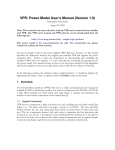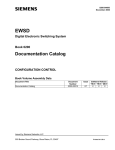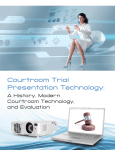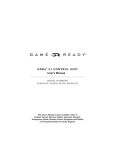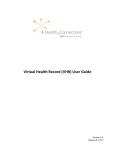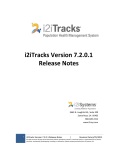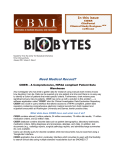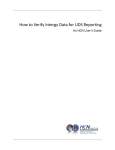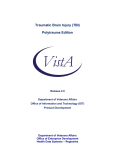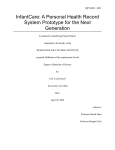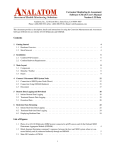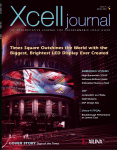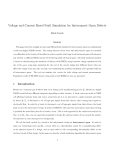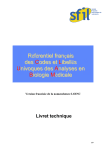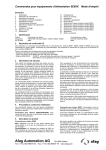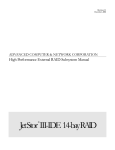Download This link will open in new windowRELMA Overview and
Transcript
Ping Chong HO
Health Informatics Analyst 1
21 June 2013
© 2011 Regenstrief Institute and James Case
The materials are from LOINC and RELMA tutorials.
This work by Regenstrief Institute, Inc and James Cases is licensed under a Creative Commons AttributionNoncommercial 3.0 United States License.
© 2011 Regenstrief Institute and James Case
© 2011 Regenstrief Institute and James Case
Using RELMA
Or…In Search of the Missing LOINC
Laboratory LOINC Meeting – June 2013
James T. Case MS, DVM, PhD
Health Program Specialist, SNOMED CT
National Library of Medicine
© 2011 Regenstrief Institute and James Case
What will we cover today?
•
•
•
•
•
•
•
•
•
•
•
•
•
•
Overview of LOINC
Reviewing new RELMA features
Installing RELMA
Setting personal preferences
Loading a Local Observation File (LMOF)
Searching for a LOINC Term
Preparing LMOF for Mapping
Review of Map Screen Functions
Setting Search Limits
Mapping Local Terms to LOINC
Viewing LOINC Term Details
Proposing/Submitting New LOINC Terms
Exporting/Printing Mapped Terms
Mapping your own LMOF data
© 2011 Regenstrief Institute and James Case
Why are we doing this?
Goals of Health Information Standards
• Interoperability – the ability to exchange
information between organizations
• Comparability – the ability to ascertain the
equivalence of data from different sources
• Data Quality – the measurement of
accessibility, completeness, accuracy and
precision (and more)
© 2011 Regenstrief Institute and James Case
Levels of Interoperability
• Basic – allows data to be exchanged between
computer systems
•
Word processing documents, text messages
• Functional – describes the standard syntax
(format) of the data
•
•
Document templates, forms, data structures
Message standards
• Semantic – requires use of standardized
content (vocabularies) within the data
structure
© 2011 Regenstrief Institute and James Case
Comparability
• Meaning of the data is consistent when shared
among different parties
•
•
Erysipelas – Human skin disease; Streptococcus Grp A
Erysipelas – Animal Septicemia/dermatitis; Erysipelothrix
rhusiopathiae
• Common terminology required
•
Should work in the background
• Words are not enough
•
•
•
•
Codes – uniquely identify terms
Vocabulary – specialized, precise terms that remove
ambiguity
Ontology – describes nature of entities and their relations
Classification – groups related terms
© 2011 Regenstrief Institute and James Case
Test comparisons
What you see in the order list
Lab A
Lab B
Test Name: Lyme Disease Serology
Measures: B. burgdorferi Ab IgG
Method: ELISA
Scale: quantitative
e.g.: Titer 1:40
Test Name: Lyme Disease Antibody
Measures: B. burgdorferi Ab IgM
Method: Immune blot
Scale: qualitative
e.g.: Positive
LOINC Code = 5062-5
LOINC Code = 6321-4
© 2011 Regenstrief Institute and James Case
Why LOINC?
“Within one laboratory, local jargon terms
may be used which are usually well
understood between colleagues, but
would not be sufficiently widely known for
communication with the outside world.”
U. Forsum et al., Pure Appl. Chem 72:555-745, 2000 Properties and Units in the Clinical
Laboratory Sciences Part VII. Properties and Units in Clinical Microbiology
© 2011 Regenstrief Institute and James Case
®
LOINC
101
Emphasis on Laboratory
LOINC
© 2011 Regenstrief Institute and James Case
Anatomy of a LOINC Term
5193-8:Hepatitis B virus surface Ab:ACnc:Pt:Ser:Qn:EIA
LOINC Code
5193-8
Hepatitis B virus surface Ab
ACnc
Component
Property Measured
Pt
Timing
Ser
System
Qn
Scale
EIA
Method
There are six major LOINC axes
© 2011 Regenstrief Institute and James Case
What is NOT part of a LOINC Name?
•
•
•
•
•
•
•
The instrument used in testing
Specific details about the specimen
Priority (e.g. STAT)
Where testing was done
Who did the test
Test interpretation
Anything that is not an intrinsic part of the name of
the result
• Other things that are carried in;
•
•
The OBR or OBX segment
An HL7 Version 3 Observation Object
© 2011 Regenstrief Institute and James Case
Component/Analyte
The substance or entity that is measured,
evaluated, or observed
-
-
Sodium
Glucose
Brucella sp. organism
Influenza A Virus antigen
Cytomegalovirus Virus antibody
Lipids.Total
5193-8:Hepatitis B virus surface Ab:ACnc:Pt:Ser:Qn:EIA
© 2011 Regenstrief Institute and James Case
Component/Analyte Structure
Analyte Name^Challenge^Adjustments
• Formal name of Analyte (e.g. Calcium)
•
Must specify any “subanalyte”
•
•
e.g. Coronavirus Ag
May have a subclass – separated by “.”
•
e.g. Calcium.Free
• Challenge - e.g, 1H post 100 gm Glucose PO
•
•
Two subparts separated by “post”
<time delay> post <challenge type>
• Adjustments/corrections
•
E.g. Adjusted to pH 7.4
© 2011 Regenstrief Institute and James Case
Property
the most difficult LOINC axis
The characteristic or attribute of the analyte that is
measured, evaluated, or observed
Major Categories
• Mass: Observations reported with mass (milligrams, grams, etc.)
in the numerator of their units of measure
• Substance: Observations reported with moles or milliequivalents
in the numerator of their units of measure
• Catalytic activity: Observations that report enzymatic activity
• Arbitrary: Results that report arbitrary units in the numerator of
their units of measure
• Number: Counts
5193-8:Hepatitis B© 2011
virus
surface Ab:ACnc:Pt:Ser:Qn:EIA
Regenstrief Institute and James Case
Property
the most difficult LOINC axis
Combine Major Categories with Subtypes for Full Property
•
•
•
•
•
•
•
•
•
MCnc – mass concentration (mass/unit vol)
MCnt – mass content (mass/unit mass)
NCnc – number concentration (number/unit vol)
TmStp – time
CCnc – catalytic concentration (activity)
Prid – presence or identity
Imp – impression/interpretation
Find – subjective or objective observation
Type – “Kind-of”
5193-8:Hepatitis B© 2011
virus
surface Ab:ACnc:Pt:Ser:Qn:EIA
Regenstrief Institute and James Case
Common Issues with LOINC Properties
Fraction (proportion) vs. Ratio
a/a+b vs. a/b
• Fraction = Part/whole
•
•
Number fraction (NFr): % Eosinophils
Substance fraction (SFr): % HGB which is A2
• Ratio = Measures multiple analytes from the same
system (specimen)
•
Mass concentration ratio - MCrto
•
•
e.g., BUN/Creat in urine specimen
Substance ratio-SCrto
•
Urea/Creatinine expressed as mmol/L (SI units)
• Relative Ratio = Measures from different systems
•
•
RelRto
RlTm – time from
actual and normal control
© 2011 Regenstrief Institute and James Case
Timing*
The interval of time over which the observation or
measurement was made
• Pt - at a point in time
• 12H - a twelve hour collection
• 24H - a twenty four hour collection
*non-Pt timings are usually associated with Rate Property
© 2011 Regenstrief Institute and James Case
System
The system (context) or specimen type upon which
the observation was made.
• Ser - Serum
• Bld - Whole blood
(RBC)
• Ur- Urine
• BldA - Arterial blood
• Liver - Liver
• Flu – Body Fluid,
unspecified
• Gast – Gastric
fluid/contents
• Food – Food or
feedstuff
• Tiss – Tissue
• XXX – To be specified
in another part of the
message
© 2011 Regenstrief Institute and James Case
System Structure
System^Super System
• Super System
• Patient is the default
• Used to indicate
•
•
•
blood product unit
bone marrow donor
fetus
photo via Xurble
818-5:A Ag:ACnc:Pt:RBC^BPU:Ord:
54417-1:ABO+Rh group:Type:Pt:Bld^fetus:Nom:
© 2011 Regenstrief Institute and James Case
Scale
• Qn - Quantitative
•
•
Continuous numeric (real, integer, ratio)
Optional operator (>, , , <)
•
When assay detection limits are exceeded
• Ord - Ordinal
•
a ranked set of possible values (1+, 2+, 3+)
• Nom - Nominal
•
•
an unranked collection of possible values
a taxonomy (e.g list of bacteria)
• Nar - Narrative
•
free text narrative (e.g., visit note)
© 2011 Regenstrief Institute and James Case
Scale (Special)
• OrdQn – Ordinal or Quantitative
•
•
Primarily used for antimicrobial observations e.g.
MIC reported as resistant, intermediate, susceptible
or as the mm diameter of the inhibition zone
Use is discouraged in other contexts
• Multi – structured text “globs”
•
•
e.g. chromatography output
Use is discouraged
• Doc – Clinical documents
• Set – Clinical attachments (headers)
© 2011 Regenstrief Institute and James Case
Method
• Methods only needed if interpretation affected
•
•
Different normal ranges
Test Sensitivity/Specificity
• Generally listed only at the generic level
•
•
•
Agglutination (limited subtypes)
Immunoassay
Probe with target amplification
© 2011 Regenstrief Institute and James Case
Hierarchies
• LOINC ‘class’
• Each LOINC axis
• Multi-axial
•
•
Component | System
Separate download
© 2011 Regenstrief Institute and James Case
Mapping Terms to LOINC
Things to Remember
• The thing ordered is not always the thing measured:
•
•
•
Blood Culture – live organism(s) identified
VDRL – Treponema pallidum Ab
Urinalysis – lots of different things
• The question (what am I measuring? e.g. Glucose) is
not the answer (e.g. 90 mg/dl)
•
You are mapping the question, not the answer!
• You must know the specifics of the component being
tested for (what is this test actually measuring?)
© 2011 Regenstrief Institute and James Case
What is in LOINC?
Content
• Term structures
• Submitted units, Example UCUM units
•
aiming toward preferred units sorting
• Synonyms
• Answer lists (increasing number)
• Text descriptions – links to info sources
about individual tests
•
•
Panel structures
Foreign language translations
© 2011 Regenstrief Institute and James Case
®
RELMA
Regenstrief LOINC Mapping Assistant
© 2011 Regenstrief Institute and James Case
Purpose of Tutorial
•
•
•
•
“Eliminate” need to read the User’s Manual
Become familiar with RELMA features
Provide some insight into mapping tips/pitfalls
Help begin the mapping process for your
institution
© 2011 Regenstrief Institute and James Case
RELMA Functions
•
•
•
•
LOINC files and indexes
Manual and automated mapping functions
Same free use as LOINC (see license)
RELMA tools transform local words in local file
•
•
•
•
•
User creates file of local term/name and codes
Assigns LOINC term to local test/battery code
“Common tests” subset to speed mapping
Context sensitive hierarchies for local use.
Flexible “Google-like” search functions
© 2011 Regenstrief Institute and James Case
New in Version
© 2011 Regenstrief Institute and James Case
New in Version (Rel. 6.0)
• Default - latest copy of LOINC details retrieved from
the loinc.org website.
•
LOINC Community Mapping project.
•
•
shared repository of local tests and variables mapped to LOINC codes
allow you to contribute your mappings back to this community
repository so that others can benefit from your seeing your work
© 2011 Regenstrief Institute and James Case
New in Version (Rel. 6.0)
© 2011 Regenstrief Institute and James Case
What’s available to download?
• RELMA - mapping and browsing tool
•
•
HL7 message converter- Makes a database
suitable for mapping
HL7 lint (finds bad messages)
•
•
•
•
LOINC database and spreadsheets
LOINC User guide; RELMA User Guide
Tools to assist language translations by part
Tools for building databases to map from
HL7 messages
• New guidance documents for mappers
© 2011 Regenstrief Institute and James Case
34
Installing RELMA®
© 2011 Regenstrief Institute and James Case
Installation Steps
• Make sure you have enough free disk space!
•
2Gb is recommended
• From CD - Start – Run – <drive>:\RELMA\Setup
• Specify installation directory
•
Life will be easier if you accept the default
• Two database files installed
•
•
RELMA.MDB – LOINC Terms Database
LMOF3.MDB – Local Master Observation File
• Two sample files included
• Run from Start – (All) Programs – Regenstrief – RELMA
© 2011 Regenstrief Institute and James Case
File Locations
• Database and Ancillary Files
•
•
•
Windows XP = C:\Documents and Settings\All
Users\Documents\RELMA\
Windows Vista = C:\Users\Public\Documents\RELMA\
Windows 7 = C:\Users\Public\Documents\RELMA\
• Sample files
•
•
•
Windows XP = C:\Documents and Settings\All
Users\Documents\RELMA\Samples\
Windows Vista =
C:\Users\Public\Documents\RELMA\Samples\
Windows 7 =
C:\Users\Public\Documents\RELMA\Samples\
© 2011 Regenstrief Institute and James Case
Running RELMA®
Version 6.0
© 2011 Regenstrief Institute and James Case
Copyright Screen
© 2011 Regenstrief Institute and James Case
© 2011 Regenstrief Institute and James Case
Main Menu/Welcome Screen
© 2011 Regenstrief Institute and James Case
Set Preferred Language
Click File, Set Preferred
Language
© 2011 Regenstrief Institute and James Case
Select Linguistic Variant(s)
Selecting a translation may
require indexes to be built
© 2011 Regenstrief Institute and James Case
LOINC Terms with Spanish Linguistic Variant
All Spanish!
© 2011 Regenstrief Institute and James Case
Setting User Preferences
© 2011 Regenstrief Institute and James Case
Set User Preferences
Select User Preferences
From the File Menu
...or from Welcome Screen
© 2011 Regenstrief Institute and James Case
Set User Preference Dialog
New File Locations:
(See prior slide for location)
Startup Screen Preference
© 2011 Regenstrief Institute and James Case
User Map Screen Preferences
Click Map Screen Tab
Auto create search terms
Include/Exclude Battery Terms
Add comments on Mappings
© 2011 Regenstrief Institute and James Case
Importing Local
Terms into RELMA
© 2011 Regenstrief Institute and James Case
4 Ways to Load LMOF Files
• Direct entry into LMOF from within RELMA (painful)
•
Handy for individual entries/edits
• Create an Access table that mimics the LMOF structure
(less painful but tedious)
•
Appendix A: RELMA Manual
• Create a delimited ASCII file from your local test
catalog (good choice)
• Load directly from HL7 v2.x messages
•
•
Pulls data from OBR and OBX segments
Stores NTE segment data
© 2011 Regenstrief Institute and James Case
Constructing a Local Dataset
Create extract of your test catalog with:
•
•
•
•
Battery/Panel Code
Battery/Panel Description or Name
*Local Code
*Test Description or Name
•
•
•
•
Include Method if Important
Units
Example Values
Laboratory Section
© 2011 Regenstrief Institute and James Case
Creating Delimited ASCII File
• RELMA can’t parse free text
•
Need to create separate fields
• Can use any of these delimiters
•
•
Tab, Semicolon, Comma, Space
Can define your own
• Fields can be in any order
• Minimum required fields
•
•
•
Local Code
Local Description
Units (highly recommended)
© 2011 Regenstrief Institute and James Case
Entering New Local Terms
into RELMA
© 2011 Regenstrief Institute and James Case
Manual Enter/Edit
View/Add/Edit Local Terms
© 2011 Regenstrief Institute and James Case
Edit Term Dialog
Edit\Add\Delete Terms
Export Terms
Text alignment option
Print Preview List
© 2011 Regenstrief Institute and James Case
Export Local Term File
Delimiters supported:
Tab, comma, bar (|)
© 2011 Regenstrief Institute and James Case
Add Local Term
MICRO
BUBPLAG
BUBONIC PLAGUE – RRT PCR
Click to Add to Current
Working File
© 2011 Regenstrief Institute and James Case
Search Local Term File
Calcium
Enter Keyword from any
Return to Full List
Field
© 2011 Regenstrief Institute and James Case
Print Preview Local Term File
© 2011 Regenstrief Institute and James Case
Steps to Import Local Terms
1. Click Import Local Terms Button from Main Menu
a) File>Import Local Terms from Delimited File
2. Locate your local terms text file
a) E.g. WinXP Sample files loaded into C:\Documents and
Settings\All Users\Shared Documents\RELMA
3. Name your Working Set
a) LMOF database can contain multiple work sets
4. Define default section (Optional)
5. Identify file delimiter
6. Assign fields to LMOF attributes
a)
b)
Ignore fields you don’t need
Combine fields if needed
7. Check “Case-sensitive” if needed
8. Click Import.
© 2011 Regenstrief Institute and James Case
Example Tab-Delimited File
© 2011 Regenstrief Institute and James Case
Importing Local Files
Select Import Local Terms
from Delimited File…
© 2011 Regenstrief Institute and James Case
Navigate to File Location
Select
Filefiles
and stored
Click Open
Sample
in
RELMA Directory
© 2011 Regenstrief Institute and James Case
Open File in RELMA
Name your working set.
RELMA allows multiple sets in
LMOF database
Select your delimiter
Import Button
© 2011 Regenstrief Institute and James Case
Fields Segregated
Assign LMOF Attribute
Choose field name
© 2011 Regenstrief Institute and James Case
Ready to Import
Minimum assignments
Now you can click the
Import button!
© 2011 Regenstrief Institute and James Case
Post-Processing of Local File
• After import, RELMA Searches for terms
(words) that it does not recognize
• Stored in a file for future reconciliation
© 2011 Regenstrief Institute and James Case
Change Local Term File
Select the Working Set
Current mapping status
© 2011 Regenstrief Institute and James Case
Alternative Pragmatic Way
• Use large set of HL7 messages
• Automatically make dataset of:
•
•
•
•
•
OBR ID
OBR description
OBX ID
OBX description
Sample of results with
•
•
•
•
Real values
Units
Abnormal flags
Normal ranges
© 2011 Regenstrief Institute and James Case
Generate Local term file from HL7 messages
Select Import Terms from
HL7 File
© 2011 Regenstrief Institute and James Case
Select File to Import
Select HL7 File
© 2011 Regenstrief Institute and James Case
Specify HL7 File Name and Sample Size
Skip import of
sample values
Name the Local Term
File (working set)
Select the number of
sample values
Select which codes to store
© 2011 Regenstrief Institute and James Case
HL7 Messages Data Statistics
© 2011 Regenstrief Institute and James Case
New Terms added to LMOF
Click on “Edit Term” to see
Sample Data
New Battery Code
© 2011 Regenstrief Institute and James Case
Sample Results for Observation
New Test Code
Sample Values from
Messages
© 2011 Regenstrief Institute and James Case
2
Lenny L’OINC says:
“Load the Sample Files
Into RELMA now!”
• Import the two sample files
provided
•
Import_Sample_OBR.txt
•
•
Contains battery code and
description
Import_Sample_OBX.txt
•
Contains test code and
description
• Create 2 working sets
• Load your personal data set
© 2011 Regenstrief Institute and James Case
Cleaning your data
© 2011 Regenstrief Institute and James Case
Preparing your Data for Mapping
• Improve mapping success by:
•
•
•
•
Expanding abbreviations
Standardizing colloquial terms
Ignoring “administrative” terms
Standardizing time references
• Can be done prior to importing
• Better to use tools built into RELMA
© 2011 Regenstrief Institute and James Case
RELMA Cleaning Tools
Use this tool to edit
unknown terms
© 2011 Regenstrief Institute and James Case
Review Unknown Local Terms
May Re-Scan File for
Unknown Terms
© 2011 Regenstrief Institute and James Case
Replace Local Terms
Replacement
Options
Assign
LMOF Attribute
© 2011 Regenstrief Institute and James Case
RELMA Cleaning Tools
Use this tool to make
global substitutions
© 2011 Regenstrief Institute and James Case
Term Substitution
Save this global substitution
for only this working set
© 2011 Regenstrief Institute and James Case
Lenny L’OINC says:
“Begin to clean your
data now!”
• Using the OBR or OBX sample
files, take 15-20 minutes to
clean up these unrecognized
terms
•
You may use your own data if
you wish.
© 2011 Regenstrief Institute and James Case
Lab Auto Mapper
•
•
•
•
Run in batch mode to find N- closest terms
Can then use this output to do final mapping
Again units are VERY important
Can pick all limits available to regular mapping
© 2011 Regenstrief Institute and James Case
Picking the Lab Auto Mapper
© 2011 Regenstrief Institute and James Case
Lab Auto Mapper Start Screen
Can restrict search to
common tests
Maximum number of terms
to return
© 2011 Regenstrief Institute and James Case
Lab Auto Mapper Start Screen
Local test code
Local terms used for
mapping
© 2011 Regenstrief Institute and James Case
Lab Auto Mapper - Mapping Screen
© 2011 Regenstrief Institute and James Case
Exporting Mapped Terms
Export Terms to
Delimited File
© 2011 Regenstrief Institute and James Case
Export Terms Dialog
Select Term Set
Select Delimiter
Check Fields you
wish to export
© 2011 Regenstrief Institute and James Case
3
Searching for LOINC Terms
© 2011 Regenstrief Institute and James Case
Simplified Search
Only Tool
© 2011 Regenstrief Institute and James Case
Search Window
Help File
Enter Search Terms
Limit to
Specific Units
Restrict to “Common
Results”
Restrict to “Common
Orders”
© 2011 Regenstrief Institute and James Case
Use Automapper
logic
Search Window
Hematocrit bld qn
“Common Tests” rank
© 2011 Regenstrief Institute and James Case
New RELMA Helpfile
© 2011 Regenstrief Institute and James Case
Context Menu
Right click to bring
up context menu
© 2011 Regenstrief Institute and James Case
Mapping Local Terms
© 2011 Regenstrief Institute and James Case
Mapping Local Terms
• Select your Working Set to Map
File>Select Local Term File to Process
• Select “Map Local Terms to LOINC” from
•
Welcome Screen
• Select the subset of terms to work with:
All
• Mapped
• Unmapped
• Set your Search Limits
•
•
Set Search Limits Button
© 2011 Regenstrief Institute and James Case
Standard Mapping Window Features
• Customizable grid
• View details of LOINC term
• Sort by column
•
•
Click column
Custom Sort
• Print or export results grid
• Spell check squiggly line to signify words
not known to RELMA
© 2011 Regenstrief Institute and James Case
Mapping Screen
View or edit local term
Enter local term number
Quick select button list
Custom Grid Configuration
© 2011 Regenstrief Institute and James Case
Configure Grid
Select elements to display
Reorder grid elements
Visually resize elements
Reset Default Configuration
© 2011 Regenstrief Institute and James Case
Quick choice buttons
Viewing LOINC term detail
© 2011 Regenstrief Institute and James Case
View Local Term Details
Select level of detail to
display
© 2011 Regenstrief Institute and James Case
View Local Term Details
Select text size
© 2011 Regenstrief Institute and James Case
Select detail display level
Select level of detail to
display
© 2011 Regenstrief Institute and James Case
Standard Mapping Screen
Begin a search
(or hit “enter”)
EEK! What’ll
I do?!
© 2011 Regenstrief Institute and James Case
Standard Mapping Screen
Click to
show words
used in
search
© 2011 Regenstrief Institute and James Case
Initial Mapping Results
Use term
checkbox
Number of LOINC
terms containing
keyword
© 2011 Regenstrief Institute and James Case
Battery terms
included in
search
Revised Mapping Results
Match units
selected by
default
Number of
matching
records found
© 2011 Regenstrief Institute and James Case
Re-revised Mapping Results
Number of
matching
records found
Match units
unselected
© 2011 Regenstrief Institute and James Case
Standard Mapping Screen
CANINE DISTEMPER VIRUS IF
Enter keywords here
Clear all
input fields
© 2011 Regenstrief Institute and James Case
Ad hoc term search
© 2011 Regenstrief Institute and James Case
Standard Mapping Screen
Navigate through
the local terms
© 2011 Regenstrief Institute and James Case
Tabbed Access to Functions
Navigate to Functions
from Mapping Page
Switch between Grid and
Tree Views
© 2011 Regenstrief Institute and James Case
Tree View
© 2011 Regenstrief Institute and James Case
Tree View
• Results displayed hierarchically
•
Defined by the multi-axial hierarchy in search
restrictions (covered later)
• Map to a term in tree by clicking Map button
or double clicking term
•
Only rows that have LOINC Codes
© 2011 Regenstrief Institute and James Case
Tree View
Can map to terms
with LOINC Codes
Cannot map to
terms
representing
LOINC parts
Tree Navigation
Buttons
© 2011 Regenstrief Institute and James Case
Assigning a LOINC Map
Click “Map” Button
Highlight correct
term
(or doubleclick)
© 2011 Regenstrief Institute and James Case
Adding Mapping Comments
Check with Frank in Chemistry
If comments
option is selected,
prompt appears
© 2011 Regenstrief Institute and James Case
Assigning a LOINC Map
LOINC Term
Assigned
© 2011 Regenstrief Institute and James Case
View LOINC Term Details
View details for a
specific LOINC Term
Right clicking on a LOINC
term brings up a Task Menu
© 2011 Regenstrief Institute and James Case
LOINC Term Details
Can scroll down a single
formatted page
Can scroll through
returned subset of
terms
Change to expanded
details view
Change text size
© 2011 Regenstrief Institute and James Case
Configure Export Options
Output Options
Include
column headers
Save Configuration
and/or Export
© 2011 Regenstrief Institute and James Case
Excel Export Format
© 2011 Regenstrief Institute and James Case
More on Searching
Mapping Screen
© 2011 Regenstrief Institute and James Case
Basic Search Syntax
Special
Character(s)
Example
Definition
“ “
Influenza “virus A”
Linked terms must appear together
AND
Morphine AND
Opiates
Both terms must appear in the search result
term
OR
Influenza OR
Parainfluenza
Either or both terms must appear in the
search result term
NOT
Influenza NOT equine
Excludes terms with the word following the
NOT. Cannot be used alone.
?
Gluc?se
(glucose,glucase)
Substitutes a single character in the string.
Cannot be used as the first character; cannot
be used in “phrases”
*
Gluc*se
(glucose,
glucuronidase, etc.)
Substitute multiple characters in the string.
Cannot be used as the first character; cannot
be used in “phrases”
© 2011 Regenstrief Institute and James Case
Search Qualifiers
Detailed help available
Includes Glucuronidase,
Glucosidase,
Glucosylceramidase, etc.
© 2011 Regenstrief Institute and James Case
Combining Search Terms
Exclude Glucosidase
Reduced number of terms
© 2011 Regenstrief Institute and James Case
Advanced Search Syntax
based on Google-like search syntax
Parameter
Description
+
Term must be included in search
-
Term must be excluded from the search
()
Group terms for subquery (i.e. A OR B; A AND B)
Fieldname:
Limit term search to the associated field (e.g. Component: glucose)
Fieldname:()
Group multiple terms in a single field
~
Fuzzy search (e.g. Hemofhilus~)
“ “~
Proximity search for multiple terms (e.g. “function panel”~1)
{}, []
Upper and lower bounds; {} exclusive, [] inclusive
\
Special character escape
© 2011 Regenstrief Institute and James Case
Applying advanced search
© 2011 Regenstrief Institute and James Case
Limiting Searches
© 2011 Regenstrief Institute and James Case
Setting Search Limits
•
•
•
•
Narrows search to specific subset of LOINC terms
Reduces number of candidate terms
Limits can be applied to all components
Component attribute can be further restricted by
number of words
• Tree structure allows for hierarchical constraints
© 2011 Regenstrief Institute and James Case
General Search Constraints
• Controls features including:
•
•
•
•
•
Limit to LOINC terms compatible with submitted units
Forced match with any specimen contained in name
Method-less terms only
Limit to components/analytes with N or fewer words in their
name
Pop up search timing statistics after each search
• Use carefully or search may not be successful
(Note parallel control switches at bottom of screen)
© 2011 Regenstrief Institute and James Case
Setting Search Limits
Click Hierarchy & Search
Limits Tab
© 2011 Regenstrief Institute and James Case
Setting search limits
Can also set most of them by toggling
buttons at the bottom of the screen
Toggle Buttons
© 2011 Regenstrief Institute and James Case
Search Constraints
Attribute trees
Local Unit Constraint:
Default is “ON”
Predefined, general search
constraints
Type toggle boxes
© 2011 Regenstrief Institute and James Case
Terms Consistent with Units
New! - Status
saved between
editing sessions
Only terms consistent
with mmol/L appear
© 2011 Regenstrief Institute and James Case
Setting Search Limits
Specimen
constraints
© 2011 Regenstrief Institute and James Case
Terms Consistent with Specimen
CSF
Enter default
Specimen
© 2011 Regenstrief Institute and James Case
Terms Consistent with Specimen
Only CSF Terms are
returned
© 2011 Regenstrief Institute and James Case
Setting Search Limits
New! - Exclude laterality
© 2011 Regenstrief Institute and James Case
Exclude laterality
Laterality terms
© 2011 Regenstrief Institute and James Case
Setting Search Limits
New! - Restrict to
common orders
© 2011 Regenstrief Institute and James Case
Restriction to common orders
New! Common
orders rank
Large number of
candidates
© 2011 Regenstrief Institute and James Case
Setting Search Limits
Methodless Terms
Restriction
Override Methodless Terms
Restriction
© 2011 Regenstrief Institute and James Case
Limit to Methodless Terms
Both method and
method-less terms
© 2011 Regenstrief Institute and James Case
Limit to Methodless Terms
Only Methodless
Terms Appear
© 2011 Regenstrief Institute and James Case
More on Methodless Terms
• Some LOINC categories do not have
methodless terms
• Checking methodless only will remove these
from view on results grid
• Checking additional box allows these to be
seen
© 2011 Regenstrief Institute and James Case
Methodless Only Unchecked
All terms returned
© 2011 Regenstrief Institute and James Case
Methodless Only Checked
Only Methodless
terms returned
Differ in one or
more components
© 2011 Regenstrief Institute and James Case
Conditional Methodless
More terms
returned
No method-less
term; all shown
© 2011 Regenstrief Institute and James Case
Setting Search Limits
Limit to Lab Tests Only
(No Clinical LOINC Terms)
© 2011 Regenstrief Institute and James Case
Setting Search Limits
Limit to common lab tests
© 2011 Regenstrief Institute and James Case
Setting Search Limits
Limit Number of Words in the
Component Attribute
© 2011 Regenstrief Institute and James Case
Limit Number of Component Words
Without Limit Applied:
850 terms returned
© 2011 Regenstrief Institute and James Case
Limit Number of Component Words
Restriction appears on
Toggle Bar
(cannot toggle off)
Component limited to
1 word
With Limit Applied:
68 terms returned
© 2011 Regenstrief Institute and James Case
Setting Search Limits
Include Trial, Deprecated or
Discouraged LOINC Codes with
Returned Terms
© 2011 Regenstrief Institute and James Case
Include Deprecated LOINC Terms
-You cannot map to
deprecated LOINC terms
- You are warned before
mapping to discouraged
LOINC terms
Discouraged LOINC Terms appear as an
inverted triangle
Deprecated LOINC Terms appear as
Strikethrough Text with a “Do Not”
Symbol
© 2011 Regenstrief Institute and James Case
Favor Property Restriction
Favor one type of
property over others
All other components
being equal MCnc
only will be displayed
© 2011 Regenstrief Institute and James Case
Order/Observation Restriction
Order or Observation
preference
© 2011 Regenstrief Institute and James Case
Navigating through the
Mapping Process
© 2011 Regenstrief Institute and James Case
LOINC Mapping Tactics
• Limit effort to one lab section at a time and
focus expertise
• Chemistry and hematology will be easiest
• For manufactured assays, use package insert as
source information
• Sample results give clue to property and scale
• Consider prioritizing by frequency of use
© 2011 Regenstrief Institute and James Case
Vreeman DJ, Finnell JT, Overhage JM. A Rationale for Parsimonious Laboratory Term
Mapping by Frequency. AMIA Annu Symp Proc. 2007;:771-775.
© 2011 Regenstrief Institute and James Case
More LOINC Mapping Tactics
• Try using method-less terms first
•
Specific methods can be transmitted in:
•
OBX–17 (v2.x), Observation.methodCode (v3.0)
• Examine local units or real results to verify
correct property and scale
•
Properties are rarely distinguishable in test names
• You don’t have to do it all at one sitting
•
Use the “Unmapped” function to return where you
left off
• With every release - Update previous mappings
to identify deprecated terms
© 2011 Regenstrief Institute and James Case
Common Mapping Issues
• Locally Defined Test Name Ambiguity
•
Reuse of local test code
• “Analyte-free” Local Test Names
•
•
•
•
•
(Miscellaneous serology)
Incongruent Value sets (Scale ambiguity)
Result vs. Interpretation
Available LOINC Terms too Specific/General
Panel vs. Discrete Test
•
Common in Microbiology
© 2011 Regenstrief Institute and James Case
Can’t find the
term you
want?
© 2011 Regenstrief Institute and James Case
Search Hints and Tips
• Keywords with zero frequency are ignored
•
May need to rephrase – use synonym
• Some causes for no returned terms
•
•
Too many keywords in search – uncheck some
Limits applied that don’t make sense
•
•
E.g. Method-less tests plus Method tree set to EIA
Did not find and revise words not in RELMA
•
Local units not in RELMA
• Units are GREAT discriminators
• You may have tests that need to be added to
LOINC
© 2011 Regenstrief Institute and James Case
Q and A Session
© 2011 Regenstrief Institute and James Case
Exercise
Map your own data
© 2011 Regenstrief Institute and James Case










































































































































































